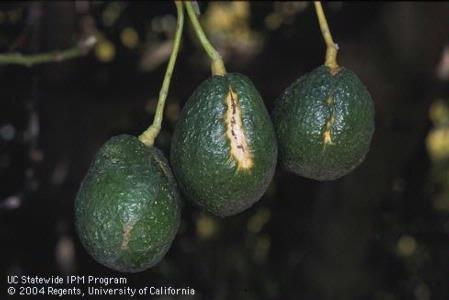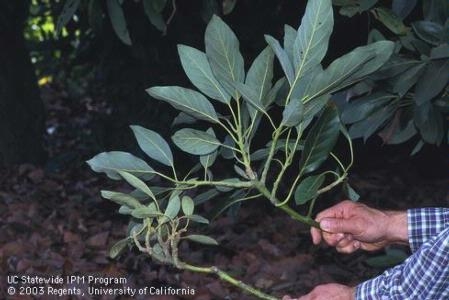Avocado sunblotch viroid (ASBVd) is a small (247 nt) pathogen that causes discoloration and disfigurement of leaves and fruit. It is transmitted by grafting, pruning tools, pollen, seed, and root grafting. Trees may recover from the symptomatic expression of the viroid and become “symptomless carrier” trees. These trees maintain high levels of the viroid in leaves, fruit and seed, but do not express the characteristic sunblotch symptoms shown above. The viroid is also readily transmitted by the pollen of these trees. One characteristic of these trees is they typically have low fruit set. If such trees were used for the production of nurse seeds, widespread transmission of the viroid could occur.
Our laboratory has developed a real time quantitate RT-qPCR protocol for quickly and sensitively detecting ASBVd in both mature field trees and small greenhouse/nursery trees.
Details of sunblotch testing
Collection of tissue for ASBVd testing is as follows: All leaves should be hardened off and mature, but not excessively old or damaged by insects or wind. Ideally, each leaf should come from a separate branch to ensure a representative sample from around the canopy of the tree. Place leaves in plastic zip lock bags with NO WET TOWELS or other material.
For mature field trees the method is: Harvest 10 leaves from each of the 4 compass points. Place the 10 North and 10 East leaves in one bag, the 10 South and 10 West leaves in another bag, so you will have “sample 1-NE, and 1-SW”, etc., 2 bags for each tree. If you see symptomatic fruit, include the fruit and 2-3 leaves from directly behind that fruit in a separate bag.
For small nursery trees or newly planted field trees (2-4 ft tall, 1-4 branches): if there are only 1-2 shoots, 2-3 leaves from each plant can be collected (at least one leaf from each shoot); for slightly bigger trees, collect 6-8 leaves from each tree (2 leaves from each branch). It is very important to collect the most mature and fully expanded leaves from the small trees. Avoid the young expanding feathery leaves.
If any pruning or cutting tools are used in sample collecting they need to be disinfected for 2-5 minutes between trees with a freshly made (within 2 hours) 20% dilution of 5% household bleach (generally speaking: 2 parts bleach to 8 parts water), then rinsed with water before cutting the next tree.
The total number of leaves collected as above should be 20 or less per bag. Samples should be sent by overnight shipping and in the summer should be placed in styrofoam containers with reusable ice packs. Results are usually available within 10-14 days after receipt, depending on demand.
Contact Georgios Vidalakis (vidalg@ucr.edu, lab: 951-827-4932, office: 951-827-3763, cell: 951-237-9948) for more information and scheduling.
Typical symptoms of ASBVd on fruit and leaves (lower left branch)
Attached Images:

